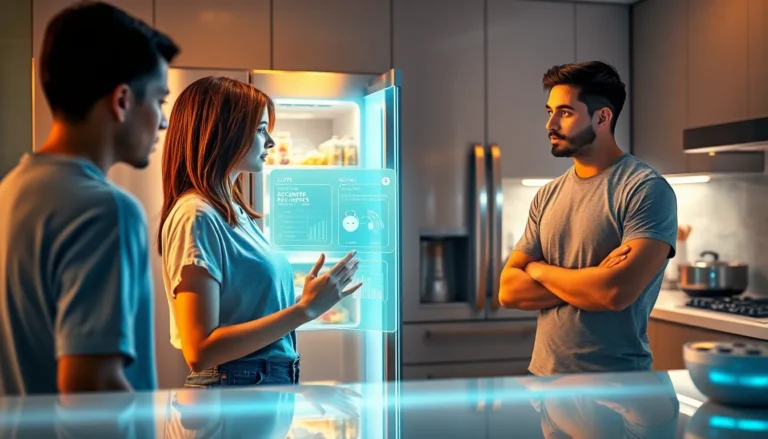Table of Contents
ToggleIn a world where everything from your fridge to your toaster is joining the digital party, IoT energy is the cool kid on the block. Imagine a smart home that not only knows when you’re home but also optimizes energy usage like a pro. It’s like having a personal energy manager who doesn’t take coffee breaks or complain about Mondays.
As technology evolves, the Internet of Things is transforming how energy is consumed, making it more efficient and sustainable. With smart devices communicating seamlessly, users can save money while reducing their carbon footprint. Who knew saving the planet could be this easy—and a little fun? Dive into the electrifying world of IoT energy, where innovation meets efficiency, and discover how it’s powering a brighter, greener future.
Overview of IoT Energy
IoT energy represents a shift towards smarter and more efficient energy management. Smart devices monitor energy usage in real-time. Sensors analyze patterns and adjust consumption automatically. Smart thermostats, for instance, can optimize heating and cooling based on occupancy, thereby reducing energy waste.
Energy-efficient appliances play a crucial role as well. They often communicate with home energy management systems, allowing for better integration and coordination. As a result, users can schedule operations during off-peak hours, lowering electricity costs.
Utility companies benefit from IoT energy too. Real-time data collection helps optimize grid management. Analyzing consumption trends allows for predictive maintenance, ultimately reducing downtime and costs.
IoT energy extends beyond residential settings. In commercial buildings, integrating smart lighting and HVAC systems can significantly cut down operational expenses. Large-scale energy management systems leverage IoT for enhancing resource allocation, leading to sustainability.
Adoption of IoT technology in energy sectors supports renewable energy integration. Smart grids facilitate the incorporation of solar and wind power by managing supply and demand efficiently. Data analytics tools maximize the advantages of these sources, ensuring reliability and stability.
Overall, IoT energy embodies a comprehensive approach to energy conservation. Enhancing awareness and engagement among users contributes to a sustainable future. This movement encourages innovation, paving the way for advanced solutions in smart energy management.
Benefits of IoT Energy

IoT energy offers multiple advantages that enhance energy management and consumption practices. These benefits not only promote efficiency but also foster significant savings.
Enhanced Efficiency
Smart devices enable real-time monitoring of energy usage, improving overall efficiency. Occupancy sensors adjust lighting based on the presence of individuals, minimizing energy waste. Smart thermostats dynamically regulate heating and cooling, ensuring energy is used optimally. Adaptive algorithms in appliances communicate with home energy management systems, analyzing usage patterns and recommending adjustments. This technology empowers users to make informed decisions about their energy consumption, driving a shift towards more sustainable practices.
Cost Savings
Cost savings become evident through the utilization of IoT energy solutions. Users witness reductions in utility bills due to optimized energy usage and scheduling. Smart appliances operate during off-peak hours, capitalizing on lower energy rates. Additionally, reduced energy waste translates to monthly savings, significantly impacting household budgets. Utility companies also benefit financially through improved grid management, reducing operational costs linked to maintenance and outages. As users embrace IoT energy solutions, they enjoy lower energy expenses while contributing to a more sustainable environment.
Applications of IoT Energy
IoT energy has numerous applications across different sectors, significantly enhancing energy efficiency and management.
Smart Grids
Smart grids leverage IoT technology to improve grid reliability and enhance energy distribution. Sensors collect real-time data on energy use and demand, facilitating better load balancing. Grid operators can make informed decisions based on analytical insights, which minimizes outages and optimizes resource allocation. Integration of renewable sources becomes seamless through these advanced grids. Peak demand management occurs effectively, leading to lower operational costs for utility companies. Eventual benefits include reduced carbon emissions and improved sustainability, fostering a cleaner energy ecosystem.
Home Automation
Home automation systems utilize IoT energy solutions to optimize energy consumption in residential settings. Smart thermostats learn household patterns, adjusting temperature settings for maximum efficiency. Appliances communicate with energy management systems to schedule operations during off-peak hours, resulting in substantial savings. These devices provide users with real-time information about their energy usage, prompting smarter consumption decisions. Furthermore, integration with smart lighting allows for adaptive illumination based on occupancy, creating a more comfortable and efficient home environment.
Industrial IoT Solutions
Industries adopt IoT energy applications to enhance operational efficiency and reduce energy costs. Smart sensors monitor equipment performance and energy consumption in real-time. Predictive maintenance solutions identify potential issues before they escalate, minimizing downtime and repair costs. Manufacturing facilities benefit from automated systems that adjust energy use based on production schedules. Data analytics helps companies identify inefficiencies and implement energy-saving strategies. Overall, industrial IoT solutions lead to a more sustainable production process, aligning with corporate sustainability goals.
Challenges in IoT Energy
IoT energy faces several challenges that can impact its effectiveness in enhancing energy management.
Security Risks
Security risks pose significant challenges in IoT energy. Devices often utilize wireless networks, making them susceptible to hacking and unauthorized access. Cybersecurity threats can compromise sensitive user data and disrupt energy systems, leading to potential outages or increased costs. Manufacturers must prioritize security features during device development, ensuring robust encryption and regular software updates. Users need to implement strong password practices and utilize secured networks to protect their smart devices. A proactive approach can mitigate many security risks, providing a safer IoT energy experience.
Interoperability Issues
Interoperability issues can hinder the seamless integration of IoT devices in energy management. Numerous manufacturers produce diverse smart devices, leading to compatibility challenges between varied systems. These issues may create fragmented user experiences, limiting the functionality of energy management solutions. To address this, industry standards must evolve to promote compatibility among devices. Collaborations between manufacturers can foster the development of unified protocols, enhancing communication across devices. Greater interoperability will enable users to maximize the benefits of their IoT energy systems, streamlining operations and improving overall efficiency.
Future Trends in IoT Energy
The future of IoT energy reveals several promising trends that shape the energy landscape. Increased adoption of artificial intelligence will enhance energy management systems, enabling smarter decision-making based on real-time data. Real-time insights allow users to optimize energy consumption patterns more effectively.
Smart contracts using blockchain technology are likely to emerge, facilitating secure and autonomous transactions between devices. Efficiency improvements in energy distribution systems will stem from enhanced data analytics, driving more accurate forecasting of energy needs. Predictive analytics will reduce downtime for energy systems, ensuring that maintenance occurs before failures.
Integration of electric vehicles into smart grids represents another significant trend. By allowing vehicles to act as mobile energy storage units, users can participate in demand response programs. Smart charging stations will optimize energy distribution and reduce charging costs during peak hours.
The rise of energy-as-a-service models will also reshape how consumers access energy. In this framework, providers offer tailored energy solutions while promoting sustainable practices. IoT devices will gather extensive data for energy providers, improving services and streamlining operations.
Cross-industry collaboration can be expected to facilitate the development of interoperable devices, reducing compatibility issues. Enhanced communication among devices will boost the overall efficiency of smart energy systems, improving user experiences. These trends highlight a future where IoT energy not only enhances user convenience but also significantly contributes to global sustainability efforts.
The evolution of IoT energy signifies a pivotal shift in how individuals and businesses manage their energy consumption. By leveraging smart devices and real-time data, users can optimize their energy use while contributing to a more sustainable future. The integration of advanced technologies not only enhances efficiency but also fosters a culture of awareness around energy conservation.
As the landscape continues to evolve, the potential for IoT energy to transform both residential and commercial sectors remains immense. With ongoing advancements in security and interoperability, the journey toward smarter energy management is just beginning. Embracing these innovations will pave the way for a greener and more efficient world, making energy savings accessible and enjoyable for everyone.







